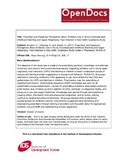| dc.contributor.author | Kotwani, Anita | |
| dc.contributor.author | Joshi, P.C. | |
| dc.contributor.author | Jhamb, Urmila | |
| dc.contributor.author | Holloway, Kathleen | |
| dc.coverage.spatial | India | en |
| dc.date.accessioned | 2018-11-15T13:30:23Z | |
| dc.date.available | 2018-11-15T13:30:23Z | |
| dc.date.issued | 2017-11-01 | |
| dc.identifier.citation | Kotwani. A., Holloway. K. and Jhamb. U. (2017) 'Prescriber and Dispenser Perceptions About Antibiotic Use in Acute Uncomplicated Childhood Diarrhea and Upper Respiratory Tract Infection in New Delhi: Qualitative Study', Indian J Pharmacol ;49:419-31 | en |
| dc.identifier.uri | https://opendocs.ids.ac.uk/opendocs/handle/20.500.12413/14129 | |
| dc.description | Diarrhoea | |
| dc.description.abstract | OBJECTIVE: The objective of the study was to explore the prescribing practices, knowledge, and attitudes of primary care doctors and community pharmacists, regarding antibiotic use in acute upper respiratory tract infections (URTI) and diarrhea in children to better understand causes of misuse and identify provider suggestions to change such behavior. MATERIALS AND METHODS: Two focus group discussions (FGDs) each were conducted with primary care government doctors (GDs), private general practitioners (GPs), pediatricians, and community pharmacists in Delhi. Each FGD had 8–12 participants and lasted 2 h. Furthermore, 22 individual face‑to‑face semi‑structured interviews were conducted with providers of varying type and experience at their workplaces. Thematic and summative qualitative content analysis was done. RESULTS: All groups admitted to overusing antibiotics, GPs appearing to use more antibiotics than GDs and pediatricians for URTI and diarrhea in children. Pharmacists copy the prescribing of neighborhood doctors. Antimicrobial resistance (AMR) knowledge was poor for all stakeholders except pediatricians. Causes for prescribing antibiotics were patient pressure, profit motive, lack of follow‑up and in addition for GDs, workload, no diagnostic facility, and pressure to use near‑expiry medicines. Knowledge was gained through self‑experience, copying others, information from pharmaceutical companies, and for some, training, continuous medical education/conferences. All groups blamed other professional groups/quacks for antibiotic overuse. Interventions suggested were sensitizing and empowering prescribers through training of providers and the public about the appropriate antibiotic use and AMR and implementing stricter regulations. CONCLUSIONS: A package of interventions targeting providers and consumers is urgently needed for awareness and change in behavior to reduce inappropriate community antibiotic use. | en |
| dc.language.iso | en | en |
| dc.publisher | Wolters Kluwer - Medknow | en |
| dc.rights.uri | http://creativecommons.org/licenses/by-nc-sa/4.0/ | en |
| dc.subject | Health | en |
| dc.title | Prescriber and Dispenser Perceptions About Antibiotic Use in Acute Uncomplicated Childhood Diarrhea and Upper Respiratory Tract Infection in New Delhi: Qualitative Study | en |
| dc.type | Article | en |
| dc.rights.holder | © 2018 Indian Journal of Pharmacology Published by Wolters Kluwer - Medkn | en |
| dc.identifier.doi | 10.4103/ijp.IJP_508_17 | |
| rioxxterms.funder | Default funder | en |
| rioxxterms.identifier.project | Default project | en |
| rioxxterms.version | NA | en |
| rioxxterms.versionofrecord | https://doi.org/10.4103/ijp.IJP_508_17 | en |
| rioxxterms.funder.project | 9ce4e4dc-26e9-4d78-96e9-15e4dcac0642 | en |


